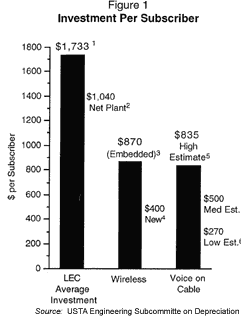
However, what is different about wireless and CATV voice services is that they have the potential to reach true mass-market status not only very quickly but at favorable costs. Further, wireless has the extra dimension of mobility that wireline service inherently cannot provide, and wireless services do not require regulatory, legislative, or legal approval to compete.
In this article, we address the questions of the magnitude and timing of the impact of wireless and cable competition on the LECs' wireline services. We also discuss likely strategies that the LECs may employ for surviving and thriving in the face of this new competition. We begin the analysis with individual assessments of wireless and cable competition. Next, we discuss one possible way to assess the joint impact of wireless and cable on the LECs. Finally, we end with an analysis of the likely strategic responses.
Before we begin, we note that it is difficult to separate the notions of competition among technologies from competition among companies. Why? Because companies are associated with their traditional technologies and services:
In point of fact, these traditional distinctions are fading rapidly, and the analysis which follows refers to competition among technologies to provide voice service.
For reasons we will discuss shortly, this perception will almost certainly change in the near future. We have developed a quantitative model of the process to determine the timing and magnitude of market share and revenue impact. The model is fully detailed in a separate report, but some of the key results are provided herein.1
A. THERE WILL SOON BE MORE CAPACITY THAN NEEDED TO SERVE ANY NUMBER OF SUBSCRIBERS AT THEIR CURRENT USAGE LEVELS.
The broadband PCS A and B 30-MHz licenses already auctioned more than doubles wireless spectrum, raising it from 50 MHz to a total of 110 MHz. Auction of the C 30-MHz license and the three 10-MHz licenses will add another 60 MHz for a total of 170 MHz. The digital TDMA and CDMA technologies multiply capacity for a given amount of spectrum by a factor of three to 10 over the existing analog AMPS technology that represents the bulk of today's cellular infrastructure.
This capacity boost will be available immediately to PCS providers who will start with a blank slate, but will also apply to cellular providers as they convert their networks to digital. Finally, smart antenna technology and the deployment of microcells in dense areas will further multiply capacity for AMPS, TDMA, and CDMA. The product of the above factors could ultimately boost capacity hundreds of times over, while to serve every person in the United States at wireline levels of usage requires a capacity boost of only about 50 times.
B. THERE WILL BE AT LEAST TWO ADDITIONAL MAJOR WIRELESS COMPETITORS IN EACH MARKET, FOR A TOTAL OF FOUR, ALONG WITH SEVERAL NICHE PLAYERS.
Three national players have already emerged:
The fourth major player in a given market will likely be one of the existing cellular carriers not already affiliated (such as BellSouth, SBC Communications, GTE Mobilnet, Ameritech, or, in the case of California, Pacific Telesis). Given the uncertainties surrounding the formation of a fourth national carrier (and ultimate role of MCI), the degree of reshuffling that has yet to occur in the industry is uncertain. The restrictions of the C licenses may mean they will be used to fill out the missing pieces for the major players and for local and niche players. The three 10-MHz licenses will probably be aquired by cellular providers to boost their bandwidth via niche and local players.
C. CELLULAR IS ALREADY VERY ECONOMICAL RELATIVE TO LANDLINE ON THE BASIS OF INVESTMENT PER SUBSCRIBER. WITH NEW TECHNOLOGY, IT BECOMES ECONOMICAL ON THE BASIS OF INVESTMENT PER MINUTE OF USE, THUS MAKING IT POSSIBLE FOR PROVIDERS TO LOWER THEIR PER-MINUTE CHARGES AND BE PROFITABLE.
Figure 1 compares the infrastructure investment per subscriber for wireline LECs and the cellular industry. Both gross and net investment (after depreciation) for wireline is significantly higher than cellular. Figure 1 does not tell the whole story since the average usage for wireline is five times that for cellular. On a usage adjusted basis, the cellular investment is five times higher than shown (or about $3,500), which helps to explain the premium in price. However, new technologies such as CDMA, TDMA, and smart antennas could raise the capacity of a system by a factor of 10 or more without significantly increasing per subscriber costs. This brings us back to the roughly $400 per subscriber, but with usage levels the same as for wireline. The wireless investment figures don't include license charges. To put these in perspective, the average cost for the A and B PCS licenses was $17 per pop. Assuming that a carrier penetrates 5% of the population (roughly where each cellular carrier is today with 25 million subscribers shared between two licensees), this translates to $340 per subscriber. Adding another $300 for marketing expenses (which usually includes buying the customer a handset) leaves a total investment of under $1,100 per subscriber, still under the undepreciated investment for wireline service and about half the cost of new wireline service.

D. THE COMBINATION OF A, B, AND C MEANS THAT MONTHLY CHARGES AND PRICES FOR USAGE HAVE NOWHERE TO GO BUT DOWN. WITH SUFFICIENT COMPETITION (AND SOMETIMES WITHOUT IT), OVER CAPACITY LEADS TO LOWER PRICES.
Historically, the real price of wireless service has declined for a given level of usage, albeit somewhat slowly. Figure 2 illustrates two possible price trends for the future: (1) a continuation of current historical trends and (2) a trend with a somewhat faster rate of price decline that is probably more consistent with the increased capacity and competition scenario discussed above. To provide a basis for comparison, the price is stated in terms of the bill for 250 minutes of peak-period monthly usage in 1994 dollars. The average monthly usage (currently well under 250 minutes) has been falling as more casual users become subscribers. As noted below, the faster price decline is consistent with high subscribership.
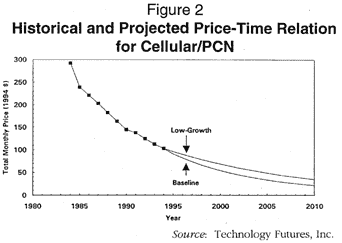
E. LOWER PRICES WILL CONTINUE TO DRIVE SUBSCRIBERSHIP GROWTH AND GROWTH IN USAGE. WHILE THIS PRICE TREND WILL NOT REVERSE THE DOWNWARD TREND IN MONTHLY BILLS, IT WILL REVERSE THE DOWNWARD TREND IN USAGE.
Figure 3 illustrates TFI's current forecasts for cellular/PCS subscribership. The high forecast was derived by fitting the Gompertz model to historical subscriber data (and assuming that the ultimate potential market is approximately equal to the number of wireline access lines). Separate analysis indicates that this forecast (which predicts 100 million subscribers by the end of 2001) is consistent with the more aggressive forecast for price decline. The low forecast (which predicts about 65 million subscribers by the end 2001) is consistent with the historical price declines. Most other industry forecasts fall within the range of the two shown in Figure 3. Given that industry analysts have consistently underestimated cellular demand, we believe that the higher forecast is more likely and, thus, we refer to it as the base case.
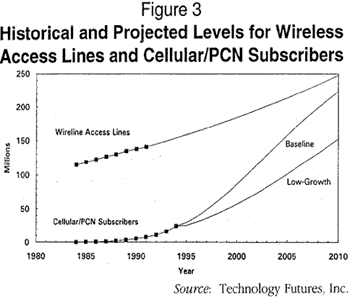
F. THE GROWTH IN WIRELESS USAGE WILL HAVE TO COME FROM SOMEWHERE, AND THE MOST LIKELY TARGET IS WIRELINE USAGE. THE PERCENTAGE OF SITUATIONS IN WHICH CELLULAR/PCS SUBSCRIBERS USE WIRELESS INSTEAD OF WIRELINE WILL GRADUALLY INCREASE AS THE PRICE FOR WIRELESS CONTINUES TO DECLINE.
Usage migration has already started for payphones and intra-LATA long distance. Calls that inherently involve usage-sensitive charges are more likely to favor wireless usage. Eventually, the wireless usage charge gets low enough where people favor the convenience of wireless over free local calls. The relationship between price and the choice of the customer to use cellular or wireline is a complex one for which there is little historical data. For the purposes of this analysis, we have opted for a simple model that reflects reasonable expectations of consumer behavior. For example, the model assumes that when the price for cellular/PCS reaches $0.10 per minute, a typical subscriber would make about 50% of these calls on wireless.
G. THUS, USAGE-SENSITIVE CHARGES, WHICH CURRENTLY ACCOUNT FOR 50% OF AN AVERAGE LEC'S REVENUE, WILL BE SLOWLY DIVERTED AWAY FROM THE LEC. WHETHER THE CAUSE IS LOST MARKET SHARE, LOWER PRICES, OR, MOST LIKELY, A COMBINATION OF THE TWO, THE IMPACT ON LEC VOICE REVENUES WILL BE HIGH.
The relationship between lost minutes of use and lost usage-sensitive revenue is not one-for-one since all calls are not equivalent in the revenue they generate. Long distance calls involving inter-LATA access charges (representing about two-thirds of usage-sensitive revenues) and intra-LATA toll charges are the most critical, not only because of their proportion on the revenue, but because they represent such a large part of the costs (access charges) or potential business (intra-LATA toll) for their prospective competitors from the long-distance industry.
With both the Sprint partnership and AT&T positioned for nationwide wireless service, one can expect these calls to be targeted. Local calls, on the other hand, are often free, so there, the revenue impact is zero. Further, since LECs currently levy a small access charge for wireless calls originating or terminating on the wireline network, there is even a positive LEC revenue impact for some calls that otherwise would have been free. Again, we opted for a relatively simple model to reflect the general outcome of a complex process. Roughly speaking, we assumed that, in the early years, a 1% drop in usage would translate to a 1/2% drop in revenues. For simplicity, we chose to model revenue losses through market share losses alone; modeling price responses by LECs to keep some of the market share would yield comparable results.
H. WITHOUT A COST PENALTY, WIRELESS FOR VOICE WILL WIN OVER WIRELINE BECAUSE OF THE HIGH VALUE THAT CUSTOMERS PLACE ON MOBILITY.
Twenty-five million cellular subscribers have already determined that they are willing to pay for mobility. Further, the adoption of cellular has been one of the fastest technology adoptions on record, in spite of relatively high prices. Another piece of evidence that people value mobility is the adoption of cordless phones. Already, over one-half of all households own cordless phones. Assuming rough parity among all other relevant factors, the consumer choice will boil down to one issue -- the importance (or lack thereof) of mobility. For voice service, there is only one logical outcome. Other factors that currently favor landline (including security, reliability, and battery lives) will be neutralized by new wireless technologies. For example, improvements in battery technology, handset technology, digital technology, cell size (smaller), and recharger infrastructure will neutralize the battery life issue for wireless.
I. EVENTUALLY, CUSTOMERS WILL WONDER WHY THEY ARE PAYING TWO MONTHLY BILLS WHEN THEY USE WIRELESS SO MUCH. AS THEY DROP LANDLINE SERVICE, THE LECS WILL BE DEPRIVED OF THE OTHER 50% OF THEIR REVENUE -- NON-USAGE-SENSITIVE CHARGES. OF COURSE, THIS IMPACT IS COMPOUNDED BECAUSE THE LEC ALSO LOSES WHATEVER MESSAGE REVENUE IT HAD THERETOFORE RETAINED.
Although there are specific circumstances where abandonment of the wireline is already occurring (e.g., at vacation homes and among students and individuals in special situations), most cellular users are currently keeping their landline phones. Our assumptions regarding the abandonment of landline phones are quite conservative. For example, our model assumes that when 80% of voice usage is on wireless, 50% of access lines will be lost. This assumption postpones much abandonment of wireline service to after 2000. Nevertheless, there is some evidence that our relationship between lost wireline usage and lost access lines is overly conservative and that many users would happily abandon landline service today given the right incentives.
J. IF WIRELESS GROWTH IS RELATIVELY FAST (AS IN OUR BASELINE CASE), THE LECS WILL BEGIN TO FEEL A NOTICEABLE REVENUE PINCH BY THE END OF 1998. IF GROWTH IS SOMEWHAT SLOWER (LOW-GROWTH CASE), THAT SAME PINCH MAY BE DELAYED UNTIL 2000 OR 2001.
Figure 4 summarizes our assessment of the impact of wireless services on wireline voice revenues. Note that we compare the two wireless competition curves (baseline and low-growth) to the no-competition case in which we assume that:
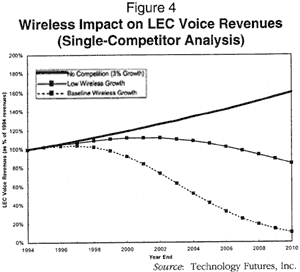
Note also that these results represent a "single-competitor" analysis in the sense that the LECs and wireless providers are assumed to be the only players. To facilitate comparison, we have normalized everything by the LECs' 1994 collective revenue. For the baseline case, wireline revenues begin to fall dramatically after 1998. For the low-growth case, wireline revenues continue to rise until 2001, and then begin to decline.
To estimate the competitive impact, we first consider the pace by which cable telephony will be offered (i.e., availability) to the public, and then consider the percentage of those customers that choose to subscribe. As with the wireless analysis, we build and use the model to estimate the impacts of cable voice competition on market share and revenues.
A. CABLE COMPANIES ARE RAPIDLY MODERNIZING THEIR NEWWORKS WITH FIBER OPTICS IN THEIR TRUNK AND SUPERTRUNK PLANTS. THE RESULTING HYBRID FIBER/COAX SYSTEMS SET THE TECHNOLOGICAL GROUNDWORK FOR PROVIDING CABLE VOICE TELEPHONY.
With a fiber/coax system, fiber is extended from the headend to nodes in the field. A coaxial cable that passes up to 500 customers is connected to each node. Fiber/coax systems greatly improve the reliability and maintenance costs of cable systems by eliminating a large proportion, if not all, of the amplifiers required for coaxial cable. Since each fiber serves a limited number of customers, the cable company can provide standard cable television and a customer-dedicated digital pathway, which allows them to offer customer-addressable video on demand. These benefits alone are enough to justify upgrading from coax to fiber/coax. The cable industry is moving so quickly that most of the U.S. cable plant will be fiber/coax by 2000.
B. CABLE COMPANIES WILL LIKELY ADD VOICE CAPABILITY TO THEIR NETWORKS. THE INCREMENTAL INVESTMENT IS LESS THAN THAT FOR TRADITIONAL TELEPHONY.
The addition of voice services on cable becomes practical as firms are able to get rid of troublesome amplifiers, reduce the number of customers served on a given cable run, and shorten the length of the cable run. The equipment to provide cable voice is already available in prototypes, and commercial versions are expected this year. Assumptions and estimates of the cost of adding voice to an existing fiber/coax vary (Figure 1). However, even the highest estimate (which includes switching) is well below that of traditional telephony. So efficient is fiber/coax at providing a combination of voice and video services, that some telephone companies are moving rapidly to the technology themselves. Not only do they expect to reduce capital costs, but also to reduce operating and maintenance costs.
C. REMAINING REGULATORY AND OTHER PROBLEMS WILL BE OVERCOME, THUS ALLOWING FULL PROVISION OF VOICE SERVICES.
Unlike cellular companies, cable providers must get regulatory approval to offer voice service. Although they have such approval in some states, they have yet to get it in many others. Even if Congress passes a telecommunications bill, it is unclear how many regulatory and legal issues will be left to solve. Also, the cable industry cites other constraints such as the lack of local number portability and the lack of interconnection and resale agreements with the LECs. We have assumed that all of the regulatory and related issues are cleared up by 2001 and that the percentage of customers to which a cable company would have difficulty providing voice service declines linearly between now and then. In summary, we derive a curve that estimates the percentage of wireline subscribers with a cable/voice option. In addition to estimates of uncertain regulatory issues, this curve depends upon the following percentage estimates: wireline users subscribing to cable, cable homes passed by fiber, and fiber with voice capability. Our relationship estimates that about 10% of wireline users will have a cable/voice option by mid-1997, growing somewhat exponentially to about 80% by 2001.
D. IN OUR MODEL, CABLE COMPANIES CAN CHOOSE ONE OF THREE PRICING STRATEGIES: UMBRELLA, AGGRESSIVE, OR VERY AGGRESSIVE. THE EXTENT OF MARKET SHARE CAPTURED FROM THE LEC DEPENDS LARGELY ON THE OPTION CHOSEN.
Under the umbrella strategy, the cable company would set their price enough below the LEC to attract price-conscious customers, but would allow the LEC to be the price-leader. The umbrella scenario is patterned after the trend in market share for AT&T's competitors in the long distance market, with the cable company ultimately capturing 40% market share.
Under the very aggressive strategy, the cable company leverages its cost advantage to price as low as it can, sacrificing margin for market share. The very aggressive scenario assumes that the cable company captures 70% of the subscribers that it can serve (as discussed in the previous section) in about six years. (The 70% ultimate market share is consistent with reports from the United Kingdom where cable companies have begun to offer voice services in competition with British Telecom.) The very aggressive case is likely to be achievable only for combinations of existing cable companies and long-distance carriers where the national brand-name awareness, telecommunications knowhow, and financial strength of the latter are highly leveraged (and if the LEC doesn't respond with lower prices of its own). The aggressive scenario is simply an average of the other two scenarios. Again, please note that the market share percentages apply only to the segment of the wireline market which is forecast to be "cable/voice-ready."
E. THE INITIAL IMPACTS ON LEC REVENUES WILL BE THROUGH USAGE-SENSITIVE CHARGES, SINCE MANY CUSTOMERS MAY KEEP THEIR LEC SERVICE AS A BACKUP. EVENTUALLY, AS CONFIDENCE IN CABLE/VOICE RELIABILITY GROWS, CUSTOMERS WILL CHOOSE ONE OVER THE OTHER.
Our cable model assumes the same relationships among lost minutes of use, lost access lines, and lost revenue as our wireless model. Again, the relationship between lost access lines and lost usage may prove to be too conservative, since cable/voice will be viewed by customers as a direct substitute much earlier for cable/voice than for wireless.
F. REGARDLESS OF THE STRATEGY PURSUED BY CABLE FIRMS, THE LECS WILL BEGIN TO FEEL A NOTICEABLE REVENUE PINCH BETWEEN 1998 AND 2000. IF A VERY AGGRESSIVE STRATEGY SIMILAR TO THE ONE THAT WE HAVE POSTULATED CAN BE -- AND IS -- PURSUED, THAT PINCH COULD BE VERY PAINFUL BY THE TURN OF THE CENTURY.
The revenue impact over time is shown in Figure 5. Note that we compare the three cable competition curves to the no-competition case (as in the wireless analysis). Again, note that these results represent a "single-competitor" analysis in the sense that the LECs and cable/voice providers are assumed to be the only players. To facilitate comparison, we have once again normalized everything by the LECs' 1994 collective revenue. For all three scenarios, the revenue impact eventually flattens out as the cable firms reach their maximum allowable market share (as we have defined them for each scenario). At this point in time, there are too many uncertainties to assign probabilities to these scenarios.
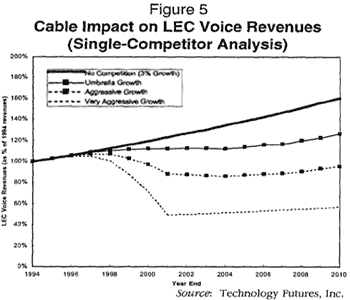
Although this obviously simplifies a complicated situation, the unique advantage of mobility may provide substantial justification for this assumption. Of course, we need to distinguish between technology and companies here. The cable company may provide wireless service and cable-based service (at the expense of the LEC). By the same token, an LEC with an affiliated company could also provide such a combination.
As we have modeled it, the joint impact of wireless and cable competition could cause a severe reduction of LEC revenues as early as 2000.
Figure 6 summarizes our assessment of the joint impact on wireline voice revenues. We compare the six possible joint-competitive conditions (two wireless scenarios and three cable scenarios) with the no-competition case that we defined in the wireless analysis. Once again, we have normalized everything by the LECs' 1994 collective revenue to facilitate comparisons. Even the mildest joint-impact case (low-growth wireless, umbrella cable) has a tremendous impact on LEC voice revenues after the turn of the century.
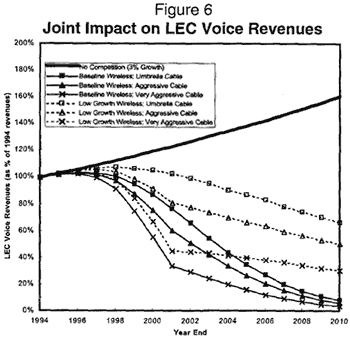
Certainly, most large LECs have commonly-owned cellular companies that will participate in the growth in the wireless side of the business (although this may be small consolation to those within the LEC entity). Entry in cable TV and long distance services by LECs will make up for additional losses. Also, there are new digital services about to reach the mass market that offer tremendous opportunities for which the LECs have natural advantages. Even the most limited of these services, ISDN, provides bandwidth (at least 64 Kb/s) that exceeds by a factor of at least five the bandwidth (analog or digital) allocated for a cellular or PCS voice call. Further, mass market digital services at wideband (about 1.5 Mb/s) and broadband rates (several Mb/s and above) are likely to be economically achieved on wireline networks well before wireless networks.
However, there are some things that will make the LEC response difficult. First, some of the new competitors have the advantages of national brand awareness, strong telecommunications experience, and deep financial resources. Second, the new technologies used by the competitors have significant cost advantages over the existing technology that comprises much of a typical LEC's infrastructure. Third, LECs are faced with substantial regulatory restrictions regarding their actions, with their competitors eager to keep it that way.
None of these are challenges that cannot be overcome, but one thing is clear: significant LEC investment is required (1) to make the pie bigger, (2) to take their share of someone else's slice, and (3) to keep their fair share of their own pie. Their competitors are adopting the technologies of the future -- fiber, SONET, and ATM switching, and digital wireless. (I cannot think of any competitors that are installing traditional twisted pairs!) To compete on even terms, they have no choice but to adopt them rapidly also. Although the copper loop plant still has tremendous economic value, this value is transitory in the sense that LECs must ultimately walk away from a tremendous sunk investment -- sooner rather than later. Their alternative is to ride the ship down at a pace suggested by the curves presented herein. Given the tremendous opportunities in an industry as exciting as telecommunications, this is not the choice most LECs have in mind.